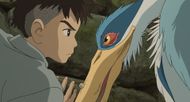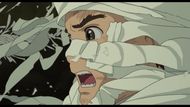The Boy and the Heron is a Ghibli movie by Hayao Miyazaki, and it is a film so deeply personal, abstract, and soul-stirring that I found myself emotionally gutted and uplifted all at once. Watching this film felt like being invited into Miyazaki’s dreamscape, one final time. The film opens in a Japan ravaged by war.
Within minutes, we’re introduced to 12-year-old Mahito. He is grieving the loss of his mother, killed in a fire caused by World War II bombings. And from the get-go, I felt a deep emotional weight. There’s no sugarcoating here. Miyazaki doesn’t romanticize the pain. He lets us sit with it.
That silence becomes the emotional core of The Boy and the Heron film, and as someone who’s personally navigated grief, I found this portrayal honest and unsettling. The mundane becomes unbearable, and even acts like putting on a uniform or staring at a new home feel hollow. It's vintage Miyazaki, where the small becomes colossal and the quiet speaks volumes.
Then comes the Heron. At first, he feels like a chaotic force of nature, urging Mahito to follow him, to find his "still alive" mother inside an abandoned tower. But the Heron isn’t just a trickster. He’s the embodiment of death, the whisper of denial, the absurdity of grief, and eventually, a reluctant guide.

His transformation over the course of the film mirrors Mahito’s own journey. From denial to acceptance. From despair to a flicker of hope. The Heron is, in many ways, the most complex "animal spirit" Miyazaki has ever created.
When Mahito enters the tower, we descend with him into a kaleidoscope of dream logic. At first, I felt disoriented. The narrative was loose, slippery, and characters appeared and vanished, logic bent and twisted. It reminded me of the way dreams work. Just when you think you understand the rules, the world changes.
Here, time folds onto itself. Mahito meets his great-uncle, the architect of this crumbling world, who offers him a chance to inherit and rebuild it. The implication is obvious—this is a conversation between an older Miyazaki and a younger version of himself.
The great-uncle is weary, afraid of what will happen when he can no longer create. Mahito in The Boy and the Heron is torn between embracing this legacy or rejecting it entirely.
The tension here hit me hard. As a fan, I’ve always wondered who could ever "replace" Miyazaki. But through Mahito, Miyazaki gently suggests that maybe no one should. Maybe the next generation shouldn’t recreate what he built, but instead forge something entirely new. That revelation was as beautiful as it was bittersweet.
Thematic depth in The Boy and the Heron

The Boy and the Heron carries the thematic weight of Miyazaki’s entire filmography. The shadow of war, ever-present in The Wind Rises, hangs heavily here. The horror of Mahito’s mother’s death is never forgotten, and the destructive force of violence simmers in the background.
But war isn’t the only force at play. The central idea of The Boy and the Heron movie is the creation of art, worlds, and meaning. The great-uncle's crumbling domain is a metaphor for a life spent building stories. And his fear of what comes after is unmistakably autobiographical. I could feel Miyazaki's voice trembling behind every frame.
The film doesn’t offer clear answers. Instead, it asks: What is the value of life? What does it mean to let go? To move on? For a director nearing the end of his journey, these questions feel earned. He’s not just telling a story; rather, he’s interrogating his legacy.
Final thoughts
Watching The Boy and the Heron felt like saying goodbye. Hope that the next generation won’t simply replicate Miyazaki’s worlds, but create new ones. This film is Miyazaki talking to himself. But it’s also him talking to us. And what he says is: Live. Create. Let go.
